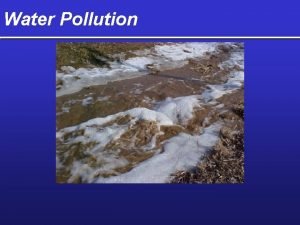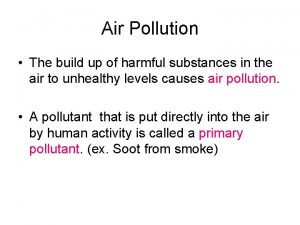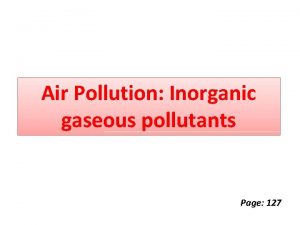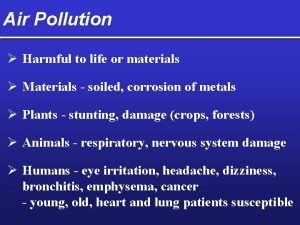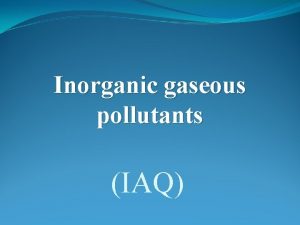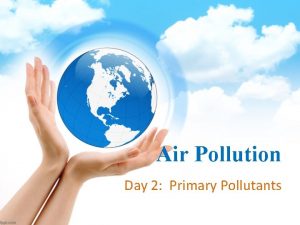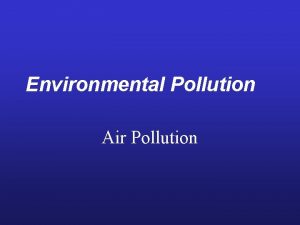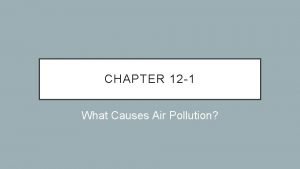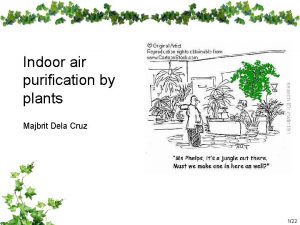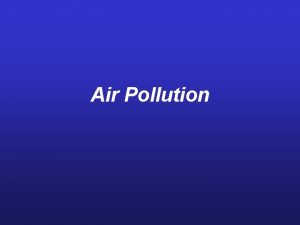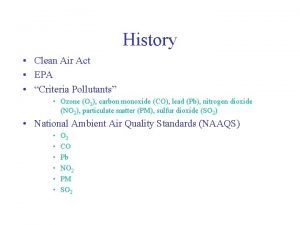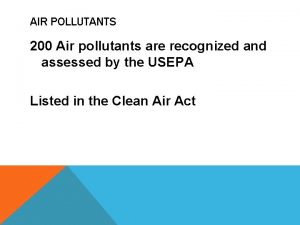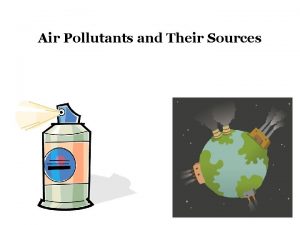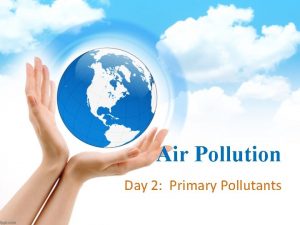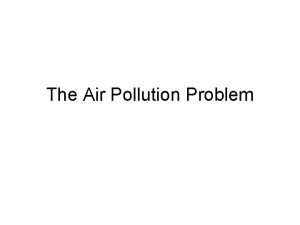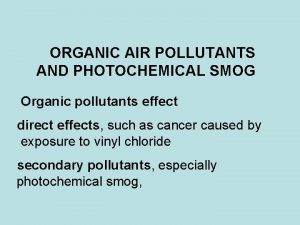Criteria Air Pollutants EPA uses six criteria pollutants











- Slides: 11

Criteria Air Pollutants EPA uses six "criteria pollutants" as indicators of air quality 1. 2. 3. 4. 5. 6. Nitrogen Dioxide: NO 2 Ozone: ground level O 3 Carbon monoxide: CO Lead: Pb Particulate Matter: PM 10 (PM 2. 5) Sulfur Dioxide: SO 2

Nitrogen Dioxide (NO 2) Properties: reddish brown gas Effects: acid rain, lung and heart problems, decreased visibility (yellow haze), suppresses plant growth Sources: fossil fuels combustion, power plants, forest fires, volcanoes, bacteria in soil

Tropospheric Ozone (O 3) Properties: colorless, unpleasant odor, major part of photochemical smog Effects: lung irritant, damages plants, rubber, fabric, eyes, reduce resistance to colds Sources: Results from interactions of sunlight, nitrogen oxides, and volatile carbons (photocopiers, cars, industry, gas vapors, chemical solvents, incomplete fuel combustion products)

Carbon Monoxide (CO) Properties: colorless, odorless, heavier than air Effects: reacts with hemoglobin – reduces ability of blood to transport oxygen Sources: incomplete combustion of fossil fuels 77% from auto exhaust, cigarettes • 5. 5 billion tons enter atmosphere/year

Lead (Pb) Properties: solid, toxic, metal Effects: accumulates in tissue; affects kidneys, liver and nervous system (children most susceptible); possible carcinogen Sources: particulates, smelters, batteries, paint, leaded gasoline (banned in developed countries) • 2 million tons enter atmosphere/year

Suspended Particulate Matter Properties: particles suspended in air (<10 um) Effects: lung damage, mutagenic, carcinogenic, teratogenic, shortens life Sources: burning coal or diesel, volcanoes, factories, unpaved roads, plowing, lint, pollen, spores, burning fields

Sulfur Dioxide (SO 2) Properties: colorless gas with irritating odor Effects: produces acid rain (H 2 SO 4), breathing difficulties, lichen and moss are indicators Sources: burning high sulfur coal or oil, smelting or metals, paper manufacture • Combines with water and NH 4 to increase soil fertility

Effects of Air Pollution • Mechanisms to protect respiratory system from pollutants – Hairs in nose that filter large particles – Sticky mucus in lining of upper respiratory tract – Sneezing & coughing – Cilia lining upper respiratory tract

Effects of Air Pollution • Exposure to pollutants causes – Lung cancer – Ashtma—allergic reaction causing sudden episodes of muscle spasms in bronchial walls resulting in shortness of breath – Chronic bronchitis—persistent inflammation & damage to cells lining the bronchi causing mucus buildup, coughing, & shortness of breath – Emphysema—irreversible damage to air sacs leading to abnormal dilation of air spaces, loss of lung elasticity, & acute shortness of breath • Estimated 150, 000 -350, 000 US citizens die annually from indoor and outdoor air pollution

Temperature Inversions • Subsidence Temperature Inversion – Large mass of warm air moves into a region at high altitude and floats over a mass of colder air near the ground • Radiation Temperature Inversion – Occurs at night as the air near the ground cools faster than the air above – As the sun rises & warms earth’s surface, radiation inversion disappears by noon dispersing pollutant build-up • Prolonged temperature inversions – City located in a valley surrounded by mountains that experiences cloudy & cold weather during part of the year – Surrounding mountains block sun needed to reverse nightly radiation inversions – City with several million people & motor vehicles in an area with sunny climate, light winds, mountains on three sides, & ocean on the other • Los Angeles basin

Kyoto Protocol • 1997: signed by some 160 nations at the third United Nation Framework Convention on Climate Change conference (UNFCCC). – The protocol calls for the first ever legally binding commitments to reduce carbon dioxide and 5 other greenhouse gas emissions to 5. 2 % below 1990 levels by 2012 • 2005: Kyoto Protocol goes into effect. Signed by major industrial nations except US. – Different levels of emissions restrictions were placed on MEDCs and LEDCs – Al Gore signed but Senate never ratified so protocol is not legally binding in U. S. • US did not sign because of the lack of restrictions on LEDCs and b/c it may harm economy of U. S. – GWB did not sign because of uncertainty in global warming predictions and costs of controlling emissions would unfairly disadvantage businesses while China and India had no restrictions • 2007: Supreme Courts ruled that EPA had authority to regulate greenhouse gases under Clean Air Act • 2010: Under Obama – EPA proposed fuel efficiency standards that would reduce greenhouse gases 30% by 2016
 Trees
Trees Primary pollutants and secondary pollutants
Primary pollutants and secondary pollutants What is a primary air pollutant
What is a primary air pollutant Inorganic gaseous pollutants of air
Inorganic gaseous pollutants of air What is secondary pollutant
What is secondary pollutant Inorganic gases
Inorganic gases What are the secondary air pollutants
What are the secondary air pollutants Major air pollutants
Major air pollutants Air pollutants
Air pollutants Indoor air pollution sources
Indoor air pollution sources Hubungan air dengan tanah
Hubungan air dengan tanah A polygon with six congruent sides and six congruent angles
A polygon with six congruent sides and six congruent angles
